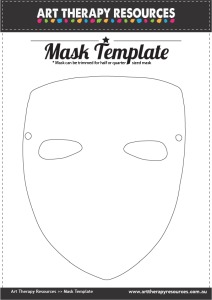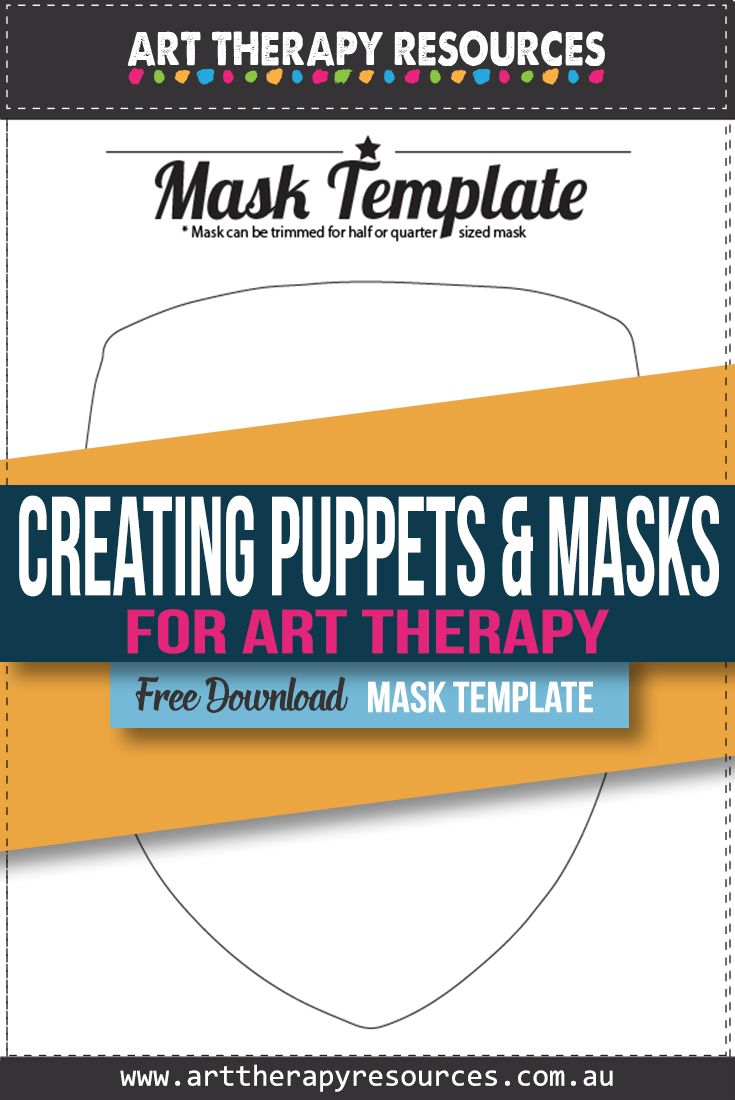THIS POST INCLUDES:
1. Benefits of Creating Puppets and Masks
2. When to use puppets and masks
3. Art Supplies for puppets and masks
4. Free Download Art Therapy Mask Template
BENEFITS OF CREATING PUPPETS AND MASKS
Creating puppets and masks are two of the most common methods of creating dimensional art pieces within art therapy. These pieces can bring a new aspect to how a client can express themselves. Puppets and masks can add a quality of magnitude through form, texture, and weight that give a physical presence to these items with dimension.
When clients create puppets or masks, they are involved in the creative process of creating a character and narrative and giving a physical weight to the character’s presence which may provide more connection then a flat 2D creation.
PUPPETS
Puppets present a strong connection for young children who may have already connected with other puppets through television. Often puppets used on television are developed within the context of providing education about numbers, words, and also social constructs such as family, friends, and degrees of ‘good’ and ‘bad’ behaviour. From this domain, puppets may already represent a high degree of trust for a young child.
Clients can use puppets to represent different people within a situation they may have experienced personally. Therefore they may assign puppets as good or bad puppets which may translate to good or bad people in their child’s personal life. However, the concept of good or bad may not always be clear cut in the puppets’ assigned personality. Instead, the child can use puppets to convey their own confusion and insecurity about a situation they may have experienced.
Puppets can often be humanized through allocating a personality or individual quirks.
MASKS
Masks can provide the function of secrecy, mystery, or disguise. To many, masks are often associated with super heroes or villains who use masks to hide their true identity. Masks are also regularly used in events to take on a persona or character, especially in cultural celebrations.
Through this process of hiding identities, masks can often be used as a way to hide true feelings or be used as a way to exhibit confidence through a developed persona. In this context, masks can often be a way to diffuse human weaknesses and instead attempt to purport external strengths.
As a mask is 3D, the client can add details to the mask on the outside (what others see) and the inside of the mask (how the client feels).
BENEFITS OF PUPPETS AND MASKS
The main goals for using puppets and masks include:
- Story telling
- Using metaphors
- A method of communication
- Role playing for future outcomes
- Role playing past experiences
- Developing a persona as a coping technique
- Using the puppet or mask to convey the client’s true feelings
- Using the puppet or mask as a projection tool for framed ‘bad’ thoughts and feelings
- Providing the client with a sense of control
- Providing clients with a safe distance to traumatic experiences through the use of puppets/masks
- Acting as a transitional object for the unspeakable experiences of the client
- Providing an aspect of play during times of seriousness (eg. illness or death)
- Forms of expression for non-verbal clients or clients with a disability
Puppets and masks provide a unique outlet for creativity and creating a narrative. The various components of puppet and mask making can include:
- Constructing the puppets including the clothes and associated props for the puppets
- Using creative writing to construct a script for each puppet
- Performance of the puppets
- Creating an environment for the puppets to perform
- Allocating various forms to the puppet such as human, animals, and fantasy
WHEN TO USE PUPPETS AND MASKS
The use of puppets and masks should be suggested at the therapist’s discretion. For children the use of puppets and masks may be viewed positively in the context of play and fun, however, for adults, using puppets and masks may appear childish and immature. This may result in resistance from your client.
Using puppets and masks is often more successful in a group setting for adults where there is a more collegial atmosphere. In this setting resistant clients can learn from more playful adult participants to encourage reticent clients.
As an art therapist, your room may contain other examples of puppets and masks on display which may also encourage reluctant clients to create their own mask or puppet.
Puppets and masks bring a unique dimensional quality to creative works. If you have a client who is showing frustrating at creating flat creative works, they may be more interested in creating dimensional works with textures and movement that can be easily incorporated into masks and puppets.
Using puppets and masks is especially beneficial for children who have experienced trauma or are undergoing significant stress. The use of puppets can help the child project their emotional experiences through the puppet’s voice.
Masks can also help children develop a superhero persona to help deal with traumatic events and develop the confidence to confront frightening emotions.
Using puppets is also good for non-verbal clients who can wield control over the behavioural actions of a puppet. Additionally, using puppets can be good for clients who are experiencing difficulties with disabilities or brain injuries as they don’t need to rely on verbal communication and can use their puppets to express any physical frustrations and experiences.
Puppets and masks can aid many clients by acting as a conduit for expressing difficult emotions as well as having difficult conversations between the client and therapist.
Puppets and masks can also be a useful tool in family therapy sessions as a way to facilitate communication between parents/caregivers and children in the family unit. These playful tools help place all family members on an equal footing as the puppets and masks are the common element amongst all family members. Everyone can have a similar sized puppet which can help reduce the anxiety that large adults may pose to a child’s point of view.
In the family unit context, puppets can also help each family member gain perspective of other family roles if they can assume different roles within the family through their puppet.
ART SUPPLIES FOR PUPPETS AND MASKS
PUPPETS:
Some useful art and craft supplies that you can use to create puppets include:
- Chicken wire
- Paper
- Glue
- Cardboard
- Paint, pencils, pens
- Styrofoam cups
- Textiles – Fabric, wool, ribbon etc
- Feathers
- Clay
- Foil
- Paper plates
- Clothespins (wood)
- Socks
- Buttons
- Paint and Pens for finger puppets (washable)
- Glovers for finger puppets
- Cardboard containers, rolls, and boxes
- Fishing line
- Dowel
- Sequins
- Pipe cleaners
- Googly eyes
MASKS:
Some useful art and craft supplies that you can use to create masks include:
- Chicken wire
- Paper
- Glue
- Cardboard
- Paint, pencils, pens
- Styrofoam
- Textiles – Fabric, wool, ribbon etc
- Feathers
- Clay
- Foil
- Paper plates
- Collage items
FREE DOWNLOAD: Art Therapy Mask Template
SIGN UP below to download the FREE Art Therapy Mask Template

BUILD YOUR ART THERAPY REFERENCE MATERIALS:
Pin this image to your Pinterest board.

SHARE KNOWLEDGE & PASS IT ON:
If you’ve enjoyed this post, please share it on Facebook, Twitter, Pinterest. Thank you!
